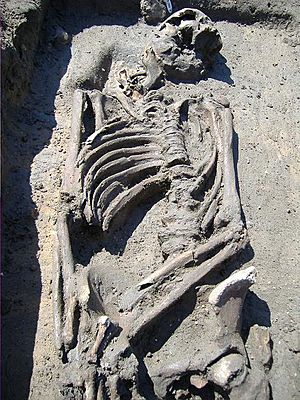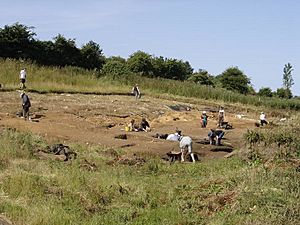Sedgeford Historical and Archaeological Research Project facts for kids
The Sedgeford Historical and Archaeological Research Project (SHARP) is a long-running project in north-west Norfolk, United Kingdom. It's all about exploring the history and archaeology of the area. SHARP also focuses on getting local people involved, offering hands-on training, and teaching others about archaeology. People from all over the world come to volunteer and learn with SHARP.
Contents
What is SHARP?
SHARP stands for the Sedgeford Historical and Archaeological Research Project. It's a big, long-term project that brings together many different ways of studying the past. They dig up old sites, but they also use other methods to learn about history.
Where is SHARP located?
The project is based in a village called Sedgeford in north-west Norfolk, which is in the United Kingdom. This area is rich in history, making it a great place for archaeological discoveries.
Who can join SHARP?
SHARP welcomes volunteers and students from all over the world. If you're interested in digging up history, learning about ancient times, or just helping out, SHARP is a place where you can get involved.
How SHARP Started
The story of SHARP began even before the project officially started.
Early Discoveries in Sedgeford
Back in 1957 and 1958, a person named Peter Jewell from the University of Cambridge dug some small trenches. He was working in a field known as "Boneyard Field." There, he found several human burials and other interesting features from the past.
The Idea for SHARP
Many years later, in 1995, an archaeologist named Neil Faulkner was talking with Bernard and Susan Campbell. They owned the Sedgeford Hall Estate. Neil wanted to lead an archaeological dig. The Campbells told him about how much archaeology was hidden in their "Boneyard" field.
SHARP is Founded
Because of that conversation, SHARP was officially started in 1996. At first, the project focused on an Anglo-Saxon cemetery. This cemetery was located just south of the modern village of Sedgeford. Since then, SHARP has explored many other sites in the area. They use different methods to learn about the past.
How Archaeologists Work at SHARP
SHARP uses many cool ways to find out about history:
- Digging (Excavation): They carefully dig up areas to uncover old buildings and objects.
- Test Pits: They dig small holes in different places to see if there's anything interesting underground.
- Geophysical Survey: This is like using a special scanner to see what's under the ground without digging.
- Fieldwalking: People walk across fields looking for old pottery pieces or tools on the surface.
- Metal Detecting: They use metal detectors to find metal objects hidden in the ground.
- Document Study: They also look at old maps and written records to learn about the past.
How SHARP is Organized
SHARP has a team of leaders, supervisors, and other members. Many volunteers and excavators also join them during the summer months (June to August). Since 1997, SHARP has been a good example of "Democratic Archaeology." This means they try to avoid strict boss-employee setups. Instead, everyone works together more equally. It's a community archaeology project, which means the local community is very involved.
Learning with SHARP
SHARP is one of the biggest places in the UK where you can get hands-on training in archaeology.
Practical Training
They teach you how to properly dig and record what you find. You can also take courses on specific topics. For example, you can learn about human bones, ancient tools (called artefacts), or the history of the Anglo-Saxons.
An Independent Charity
Unlike many other training sites, SHARP is not part of just one university. It operates as a registered UK charity. This means it's a non-profit organization that helps people learn and discover.
What SHARP Has Explored
Besides the Anglo-Saxon cemetery, SHARP has worked on many other sites. They have found things from the Iron Age, Roman times, the medieval period, and even modern times.
Important Dig Sites
- West Hall Area: This area has received a lot of attention. It was once the historic center of the modern village.
- Village Test Pits: Archaeologists have dug small test pits in many gardens throughout the village. This helps them find out what's hidden under people's homes.
- First World War Aerodrome: SHARP has also done work at an old First World War Aerodrome (an early airfield).
Amazing Discoveries
Over the years, SHARP has made some truly special and unusual finds:
- Part of The Sedgeford Torc: In 2004, SHARP found a missing piece of a gold torc from the Iron Age. A torc is a large, stiff neck ring. This piece was reunited with the main part of the Sedgeford torc, which was found in 1965. Now, the complete torc is in the British Museum.
- The Sedgeford Hoard: During the 2003 digging season, a hidden treasure was found! This was an Iron Age hoard of gold coins called staters. They were hidden inside a cow bone and discovered using X-ray technology.
- Iron Age Horse Burial: On the very same day the gold coins were found, archaeologists also discovered a horse that had been buried. This is a rare and interesting find.
- The Body in the Oven: In 2006, something very unexpected was found at a Roman site. It was a human skeleton that had been burned inside what looked like a fire-pit. This pit might have been used for drying grain or making malt. The way the body was found was so unusual that local newspapers called it "an unsolved murder." There are very few other examples like this in Europe from that time.
- Boneyard: This entire site was dug from 1996 to 2007. It revealed a very large cemetery. Almost 300 human skeletons were carefully removed. This is only a small part of how many people were actually buried there. SHARP also found a huge amount of loose human bones. The size of this burial site is very unusual, especially since there isn't a known large town nearby. This makes it a very important collection of ancient skeletons.
- Anglo-Saxon Noblewoman: An Anglo-Saxon noblewoman was found buried in the same grave as a horse skeleton that was not fully complete.
- Chalkpit Field: This area shows signs of a settlement that was connected to the cemetery at 'Boneyard'.
- Late Neolithic/Early Bronze Age Crouched Burial: In 2009, a burial was found in the Chalkpit field. The person was buried in a crouched position. Scientists used radiocarbon dating to find out it was from between 2458 and 2200 BC.
- Middle Iron Age Crouched Burial: The very next year, in 2010, another crouched burial was found about 25 meters away from the first one. This one was from the Middle Iron Age, dated between 373 and 203 BC.



